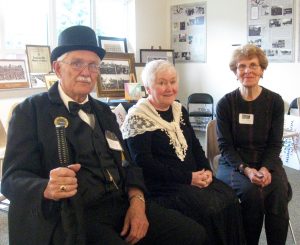
By CARL GREEN
Illinois Correspondent
Mt. Olive, IL – Building a museum about the long life of Mary Harris “Mother Jones” is a daunting proposition if for no other reason than the sheer amount of campaigning, protesting, teaching and organizing the great labor leader carried out.
But for the same reason, the Mother Jones Museum will be something important and lasting to the Labor Movement and to anyone who is a part of it or cares about it.
Both points were evident on Saturday, April 30, at a May Day celebration at the fledgling museum in Mt. Olive, the town along I-55 where Mother Jones was buried and honored with a monument in the Union Miners Cemetery. The event was called “May Day and Solidarity: Miners, Mother Jones and the Struggle for a Living Wage.”
The room was packed with people who cared about the story of Mother Jones and the Labor Movement, and each speaker brought a different story to relate and a different perspective on the history being discussed.
By the end of the afternoon, the talk had ranged far and wide, from “General” Alexander Bradley’s marches for a living wage in the Illinois coal fields to the bloody Mine Wars of West Virginia. Those in attendance were enthused but exhausted, as well.
The event was organized by Joann Condellone of Edwardsville, a member of the museum board.
 “The idea is to show the struggle, who Mother Jones was historically, what she brought to labor history, what life was like for the people who struggled along with her, and how those same issues resonate with us today – the issues of inequality and integration,” Condellone said in an interview.
“The idea is to show the struggle, who Mother Jones was historically, what she brought to labor history, what life was like for the people who struggled along with her, and how those same issues resonate with us today – the issues of inequality and integration,” Condellone said in an interview.
“We have a tremendous amount of expertise, and we have this wonderful space thanks to the city. The other piece now is to make a museum that’s interactive, that would attract young people, that would attract high school classes, so we can keep the story alive.”
THE MUSEUM
The museum is a single large room in the new City Hall, which replaced the previous building that was destroyed by a tornado in 2012. The room has several wall displays that describe and illustrate parts of Mother Jones’ life, but professional and interactive museum displays are being planned.
It was evident, however, that people and their stories will always be a vital part of the museum. The speakers shared stories that they experienced firsthand or that were passed down to them by grandparents and great-grandparents.
Among them were:
– Gomer Mabie, whose father, Edris Mabrie was shot to death after a union meeting in Springfield, IL, on Easter Sunday in 1935; he was a leader in the Progressive Miners of America, which was feuding with the United Mine Workers of America.
But Gomer Mabie’s main point was that schools today fail to teach students about the history of working people and unions.
“I just wish the whole world knew Mother Jones and what she did,” he said. “It’s a shame we’re not teaching this in our schools in American History.”
– Jeana Brown, a community organizer from West Virginia descended from miners who were caught up in the mine wars. At one point, she described how the miners had to disguise their meetings as poker games.
 “My grandfather told me that during those poker games, someone would have to lose some money and drop out and leave early, because he had to go nail the blankets on the windows and light the candles,” she said. “He might have gone in the side window. Someone else had to come in the back door, maybe 10 minutes later. Maybe a few minutes later, someone would come in the front door. Then they’d close down the poker game and hold their meeting, and as they left, it would still be a staggered thing.
“My grandfather told me that during those poker games, someone would have to lose some money and drop out and leave early, because he had to go nail the blankets on the windows and light the candles,” she said. “He might have gone in the side window. Someone else had to come in the back door, maybe 10 minutes later. Maybe a few minutes later, someone would come in the front door. Then they’d close down the poker game and hold their meeting, and as they left, it would still be a staggered thing.
“You see, there was no right to free assembly, no right to free speech, just 100 years ago,” Brown added. “It took an hour and a half to hold a five-minute union meeting, behind blankets and with candles lit. They could have been killed.”
Brown also described how Mother Jones took part in the West Virginia events that culminated in the Battle of Blair Mountain, in which armed miners organized to battle guards hired by the mining companies, leading to dozens of deaths in one of the nation’s most violent episodes.
“She came in to walk through these company stores to check the prices, she came into town to count how many mine guards and how many guns there were, she taught the women how to cut newspaper patterns to sew clothing,” Brown said. “She could have been killed. This woman was famous back then, and also she was very courageous and very smart – a very intelligent organizer.”
– Joe Jones of Vandalia, IL, described what it was like for him and his family growing up in the mining towns in West Virginia.
 “The people at the company stores, they built your house and charged you $3 a month rent,” he said. “You bought your groceries, you bought your furniture, you bought everything you had there. Every two weeks, when you got paid, you got a brown envelope, but a lot of times you didn’t have no money in it.” Miners broke away from the camps in the 1960s, he added.
“The people at the company stores, they built your house and charged you $3 a month rent,” he said. “You bought your groceries, you bought your furniture, you bought everything you had there. Every two weeks, when you got paid, you got a brown envelope, but a lot of times you didn’t have no money in it.” Miners broke away from the camps in the 1960s, he added.
– Dale Hawkins of West Virginia and from a union family, described how he took an interest in the Mine Wars and went to Blair Mountain to search for artifacts of the five-day battle. He handed around spent shells he found there. He also questioned why labor history is not better taught in schools.
“How could we have had this battle on American soil, and we don’t even know about it?” he asked.
The mountain itself now stands in danger of extinction, with coal companies seeking to have the mountaintop removed to strip it for coal.
“It’s as if a Civil War battle site was going to be stripped from the face of the earth,” Hawkins said. “How could this even be possible? And then I saw it was corporate coal, buying the politicians.”
– Joann Condellone described growing up in a union family of immigrants from north Italy. Her great-grandfather died of black lung, her grandfather was a union organizer, her mother was a garment worker and her father was with the International Workers of the World.
 “I was fortunate enough to grow up in a family that told the story – and they didn’t sugar coat it – of what it was like to be hungry, what it was like to be shot at, what it was like to be out of work, and what it was like to fight for a decent wage,” she said.
“I was fortunate enough to grow up in a family that told the story – and they didn’t sugar coat it – of what it was like to be hungry, what it was like to be shot at, what it was like to be out of work, and what it was like to fight for a decent wage,” she said.
“That’s such a basic piece of American democracy and American history,” she added. “A huge percentage of the people who struggled along with Mother Jones in those battles were immigrants.”
– Brigid Gerace portrayed Mother Jones at the event, and Jim Alderson of the museum board, as always, appeared as Alexander Bradley in his long coat and hat. Gerace recalled a 1923 visit from Mother Jones in her performance.
“Mt. Olive was full of rebels,” she said. “They were the ones who confronted the thugs and Chicago police who were set on destroying the union that they had won in the great strike in 1897. That’s what I saw in Mt. Olive, because they had the courage to fight.
“Alex was called General Bradley because he was part of the unemployed army who marched on Washington in 1894. That gave him the courage to organize the rank and file here in Mt. Olive to shut down the mines. That’s how the miners won their first real contract and the eight-hour day.”
– Rosemary Feurer, an associate professor of history from Northern Illinois University and the museum’s adviser, explained how important May Day was to Mother Jones.
“It’s the workers holiday, and of course it’s the day that Mother Jones said she was born – and she really was born on May Day, even though, officially, her birth certificate may say Aug. 18, 1836,” Feurer said.
“What she meant by that, I’m certain, is that she was reborn in the workers’ movement, in the movement for social justice, in the movement for a living wage. She wanted to be known as a person who was giving life to a new view of how the world could be organized and how justice could be accomplished.”
More information about the museum and Mother Jones can be found at the website motherjonesmuseum.org. Contributions can also be made at that website.

